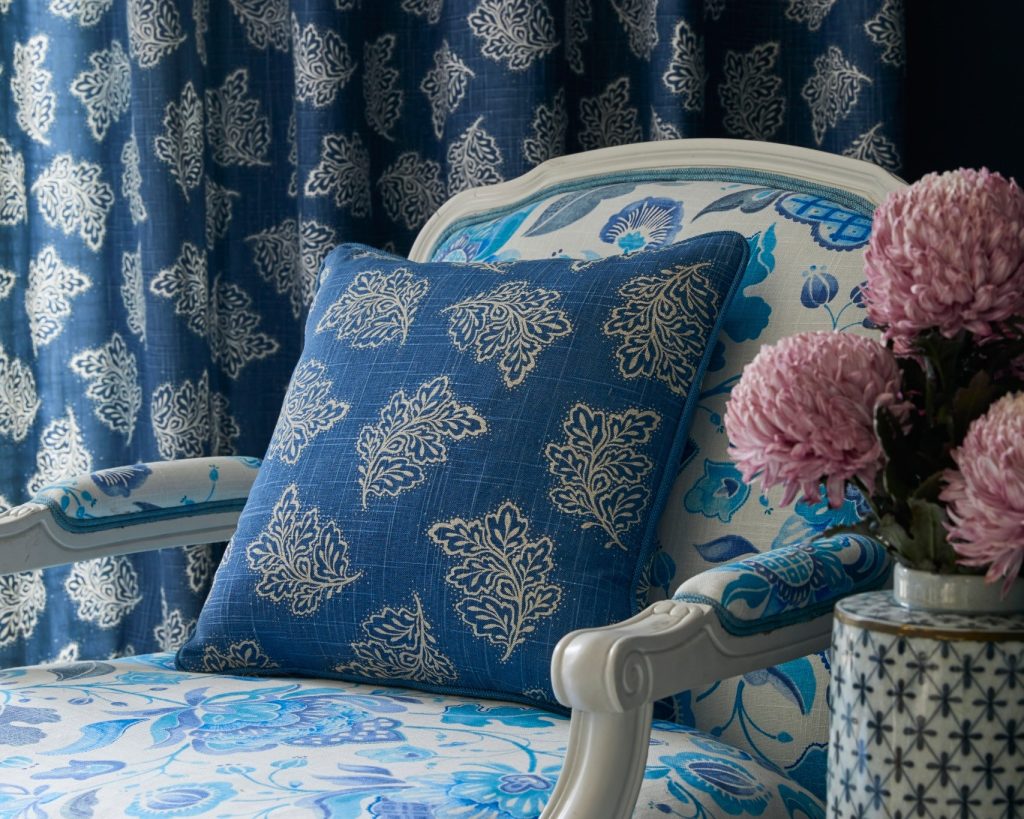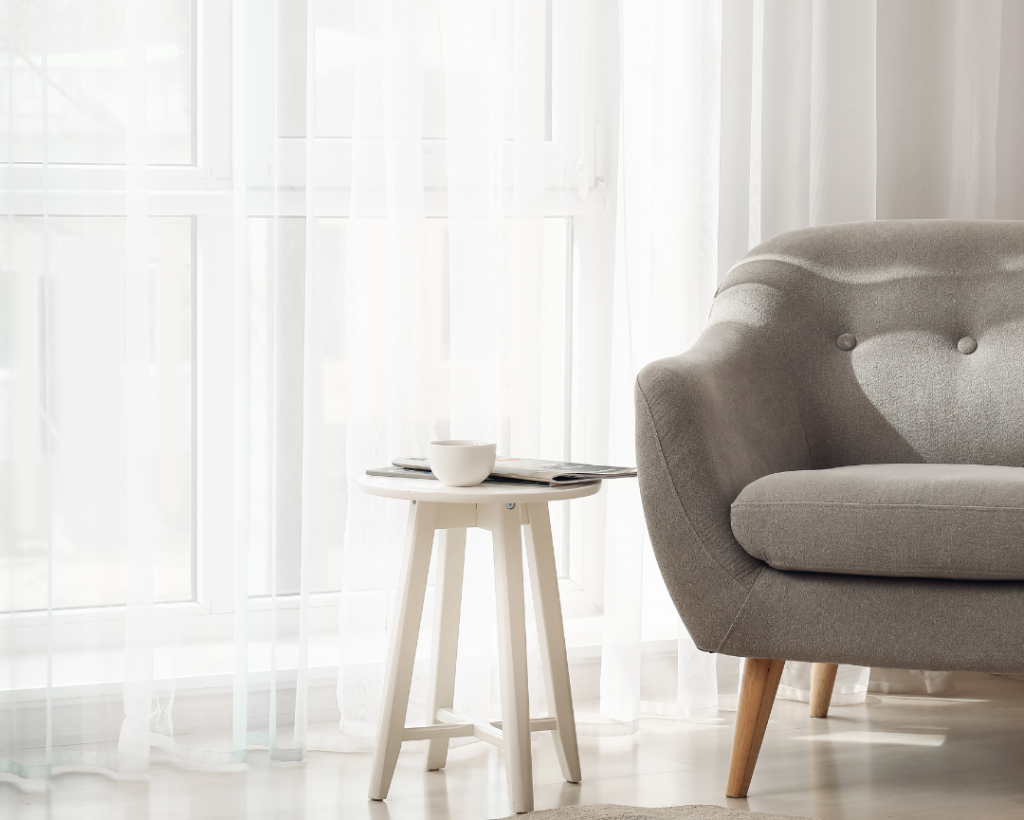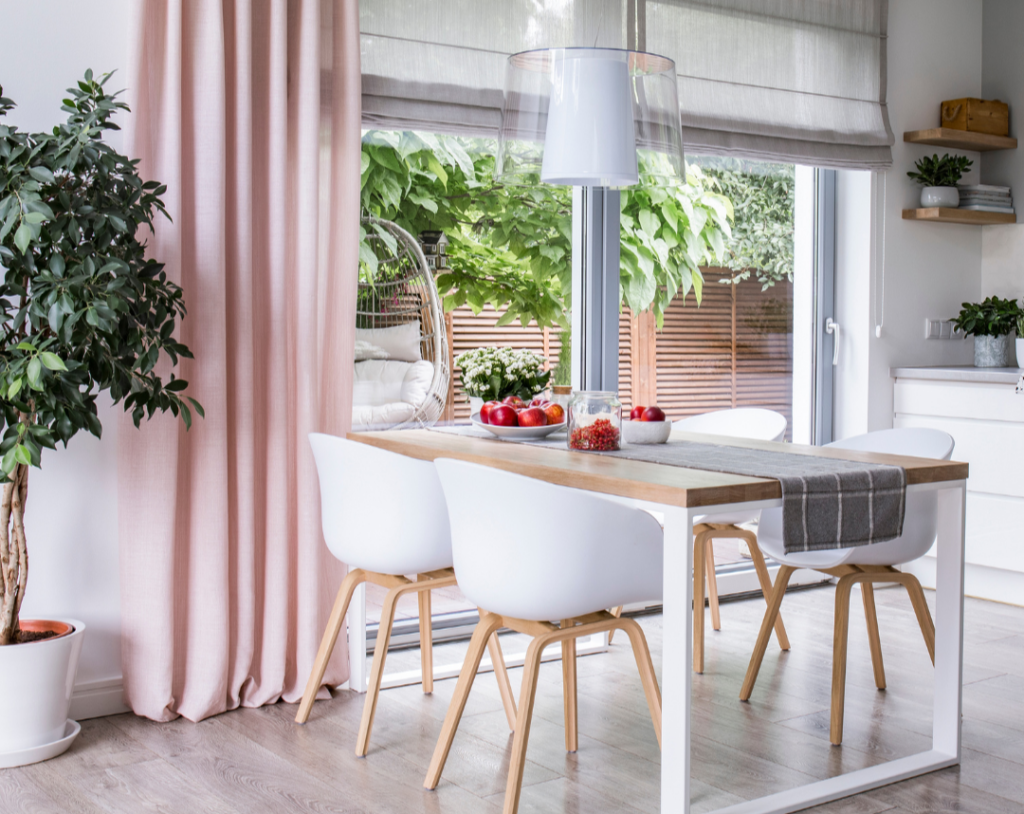You’ve decided you want beautiful curtains to adorn your window frames. That’s the easy part! The hard part is selecting the best curtain fabric for your home. This helpful guide will make your fabric selection a breeze.
3 factors to consider when selecting curtain fabrics
When selecting fabrics there is a range of important factors to consider.
Consider the design style of the room
Think about the curtain fabrics that would complement the design style of your room and house. Is your house modern, traditional, contemporary, Hamptons or Bohemian in style? Curtain selection may also be influenced by the room’s décor, colour scheme (which includes paint colour or accent pieces) or your personal style. Often, curtain fabrics are either a shade lighter or darker than the walls to create a subtle contrast. To learn more about the latest design trends, read our article Adelaide: Interior Design: 2023 home design trends.

Consider the level of light in the room
If you want the room to be light and airy, opt for sheer, lightweight fabrics such as cotton or linen. However, if you would like more privacy and darkness, choose heavier fabrics such as velvet or suede.
Consider the maintenance of fabrics
If you don’t want to spend a lot of time cleaning and ironing your curtains, opt for fabrics that are machine-washable and wrinkle-resistant. It is also important that your fabric is durable, as it will be hanging for a long time in your home.

4 fabric qualities to consider when selecting curtains
At Bob Burns Blinds, we have dozens of fabric choices. So, where do you start? When picking curtain fabrics, we encourage you to consider the following:
- Fabric weight
- Fabric coating
- Fabric material
- Fabric colour or pattern.
Fabric weight
Fabrics vary in the thickness of the threads that make up the material (grams per square metre GSM). It’s important to understand the difference between sheer, lightweight, heavier and block-out weights. Generally, the heavier the fabric, the better quality the curtains (and the higher the price).
Whilst sheer and light-weight curtains give rooms a dreamy look and are best for light-filled spaces, heavier and block-out curtains are excellent for rooms exposed to direct sunlight. Here are a few considerations:
- Lighter curtain fabrics are typically used for decorative purposes whereas heavier fabrics usually have more practical applications.
- Sheer curtains are used to diffuse light and soften the appearance of spaces.
- Lighter-weight curtains can be layered with a heavier fabric or another widow covering (such as a roller blind) to achieve a block-out effect.
- The heavier the fabric the more durable it typically is, and the more sound-absorbing qualities it will have.
- Fabric weight (especially heavier weighted fabrics) can affect how curtains hang or drape.
- Heavier fabrics have higher insulating qualities, keeping you cool in summer and warm in winter.
- The heavier the fabric, the longer the curtains will hang, the more body they will have, and the more they will pool.
- The fabric weight will influence the selection of the curtain rod, as a heavier fabric may require a stronger rod to support it.
Fabric coating
Curtain fabric coating refers to fabrics that have a coating applied to the back of them (usually heavier weighted fabrics). This helps the fabric block-out light, without applying an additional layer of lining.
Here are a few things to consider:
- Does your room require daytime privacy? If so, a coated fabric may be appropriate to achieve total privacy.
- Coated fabrics can extend the life of the textile, making it easier to clean and protecting it from UV rays.
Bob Burns Blinds have an extensive selection of coated fabrics. Whether it’s colours, prints or texture that you’re after, we have a coated fabric for every home, taste and personality.
Fabric material
The material you select for your curtains affects the look, feel and performance of the fabric. Here are our top 5 curtain materials and the pros and cons of each.
- Linen – Linen is a natural fabric that is lightweight and airy. It is strong, durable, and can be used to create a more formal look when used in heavier weights. However, there are some downsides of linen curtains which can include fading in sunlight over time (sometimes with patching), shrinking in humid environments (e.g. in bathrooms or in coastal locations), and excessive creasing which can affect the movement and length of your curtains. We recommended adding more length to your linen curtains to allow for possible shrinkage over time.
- Sheer – Sheer curtains are lightweight, easy to hang and allow some natural light to enter the room. They are perfect for rooms that need a bit more privacy but still want to maintain a light and airy feel. Unfortunately, sheer curtains don’t provide much (if any) insulation, sun protection or noise reduction. They can be difficult to clean as they are delicate and prone to snagging.
- Cotton – Cotton is a classic lightweight, breathable material that is available in a variety of colours and prints. It is also easy to clean and is a great option for any room. The disadvantage of cotton is that it can be prone to wrinkling, absorbing stains, and fading with sun exposure over time. It is also not as energy efficient as other curtain materials such as polyester or velvet.
- Polyester or man-made fibre blends – A popular material for curtains, polyester (or blend with cotton, wool or linen) is a synthetic material that is durable, easy to clean, stain resistant, will not shrink, and comes in many different colours and patterns. It also provides good insulation and is an excellent choice for rooms that need more privacy. Unfortunately, polyester curtains may attract dust and create static electricity which can be annoying. They can also wrinkle easily and may fade over time, especially if exposed to direct sunlight.
- Velvet – Velvet is a luxurious material that is soft to the touch. It comes in a variety of colours and can be used to add a touch of elegance to any room. Velvet curtains are a popular choice for theatre rooms or stately homes as they have an opulent look and can effectively block-out sunlight and sound. However, velvet curtains do have some drawbacks. They can be difficult to clean (may require professional cleaning), they can fade or discolour over time if exposed to direct sunlight and may be more expensive than other fabric options.

Fabric colour and pattern
This is the fun part! Finding a colour or pattern to complement your interior scheme can be challenging, and advice from a design consultant can be helpful.
However, here are a few design tips and tricks that you can consider.
- Curtain fabric in a similar shade to your walls achieves a subtle tonal interior. For example, bright white walls and curtains are often used in coastal or Hamptons-styled homes.
- If you’re after a more striking look, your curtain colour and design can contrast the colour wheel of your walls.
- To pull off a patterned curtain material, consider other design elements in your space. For example, is there a patterned rug, wallpaper or artwork within the space? If so, ensure the scale of curtain and interior patterns contrast rather than compete. It can also be effective to repeat your curtain pattern in other places within the room (e.g. an accent chair).
In the market for Adelaide curtains and blinds? Give us a call!
Bob Burns Blinds has an extensive range of Adelaide curtains in an array of fabrics, colours, patterns and finishes. Are you ready to transform your home with beautiful curtains that complement your home? Get your free measure and quote here!


